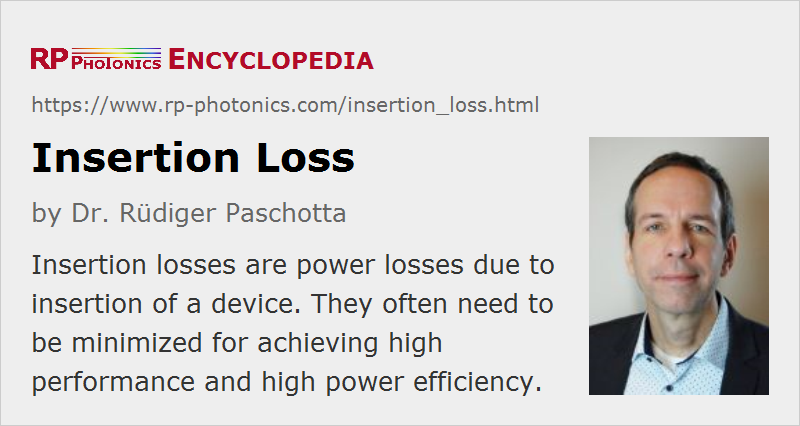Insertion Loss
Definition: power losses due to insertion of a device
German: Einfügedämpfung
Categories:  general optics,
general optics,  fiber optics and waveguides
fiber optics and waveguides
Units: %, [[decibel|dB]]
Author: Dr. Rüdiger Paschotta
Cite the article using its DOI: https://doi.org/10.61835/yma
Get citation code: Endnote (RIS) BibTex plain textHTML
If an optical device is inserted into a setup, some of the optical power may be lost in the device or at optical interfaces. Some examples:
- A fiber connector, a mechanical splice or a fusion splice may be used to connect two fibers, instead of having a single continuous fiber. Some of the optical power will be lost due to non-perfect interfaces, not exactly matching effective mode areas or similar factors.
- The larger amount of insertion loss may be intentionally inserted in the form of a fiber-optic attenuator.
- A Faraday isolator is inserted after the output of a laser in order to prevent it against back-reflections. Some power is lost at imperfect anti-reflection coatings of the isolator and possibly by parasitic absorption or scattering in the optical elements.
The insertion loss (or attenuation) is usually specified in decibels, calculated as 10 times the logarithm of base 10 of the ratio of input and output powers. For fiber connectors, for example, it is often of the order of 0.5 dB. High-quality fusion splices may reach values like 0.02 dB.
For high-power devices, a high insertion loss is often unwanted not only due to the power loss but also because of possibly strong heating effects resulting from absorbed light.
A convenient method for measuring insertion loss is optical time-domain reflectometry. With that, the insertion loss of multiple optical elements along a fiber can be measured separately.
Optical Loss Testers
For use mainly in optical fiber communications, there are optical loss testers with which insertion losses can be quite conveniently measured.
More to Learn
Encyclopedia articles:
Questions and Comments from Users
Here you can submit questions and comments. As far as they get accepted by the author, they will appear above this paragraph together with the author’s answer. The author will decide on acceptance based on certain criteria. Essentially, the issue must be of sufficiently broad interest.
Please do not enter personal data here; we would otherwise delete it soon. (See also our privacy declaration.) If you wish to receive personal feedback or consultancy from the author, please contact him, e.g. via e-mail.
By submitting the information, you give your consent to the potential publication of your inputs on our website according to our rules. (If you later retract your consent, we will delete those inputs.) As your inputs are first reviewed by the author, they may be published with some delay.





2021-07-27
Is there a significant difference between SMF insertion loss and MMF insertion loss? If so, which one is usually higher?
The author's answer:
Multimode fibers often have higher propagation losses than single-mode fibers. That, however, would not usually be called an insertion loss; that term is more commonly used for specific devices or splices.